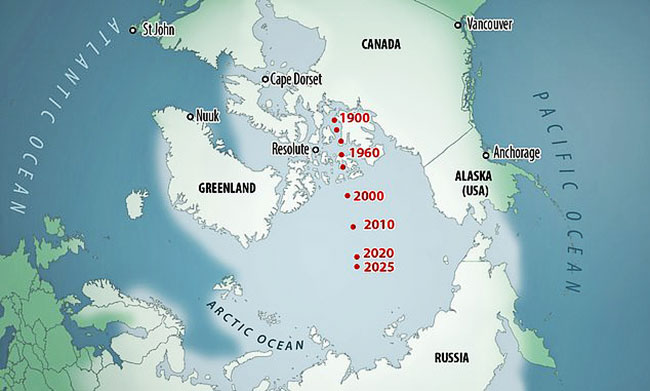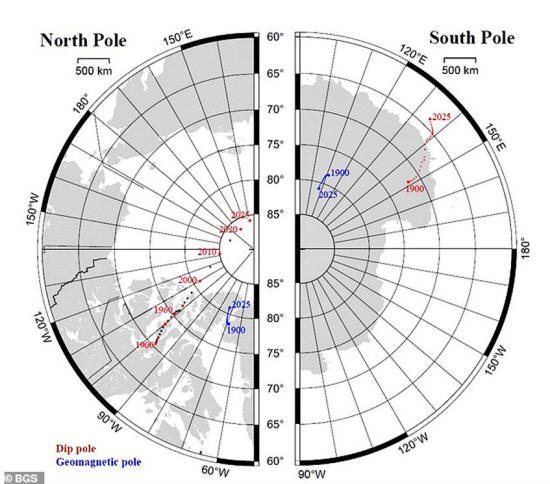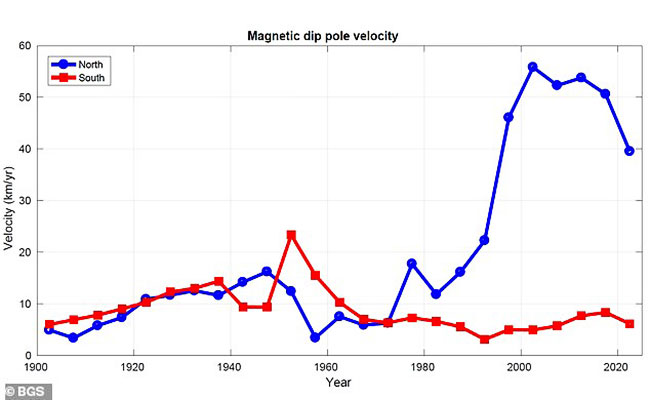|

by Jonathan Chadwick
13 December
2019
from
DailyMail Website
information sent by CFGO

New World Magnetic Map data
shows Earth's magnetic north is moving at 31 miles per year,
up from just 6.2 miles around 20 years ago,
away from Canada and towards Siberia
-
New World Magnetic Model reveals movements in the
Earth's magnetic field
-
Earth's magnetic north pole is moving towards
Siberia and away from Canada
-
Northern lights may be harder to see from Canada as
the magnetic north shifts
-
Magnetic devices and GPS systems used by military
and aviation industries rely on accurate magnetic
field readings
-
Satellite positioning data and navigation systems
thrown off course
The Earth's magnetic North Pole is travelling at an unprecedented
rate and is picking up speed as it moves towards Siberia, according
to new satellite data.
The magnetic North Pole is the wandering point on the surface of
Earth's Northern Hemisphere at which the planet's magnetic field -
created by molten iron within the planet's core - points vertically
downwards.
The latest World
Magnetic Model (WMM),
which tracks the movement of the Earth's magnetic field, shows that
the magnetic north is moving at a rate of 30 miles per year.
This is the fastest recorded shift of the Earth's north since the
mid-16th century and could cause havoc for aviation and
navigation systems, including Smartphone apps that use GPS.
The WMM has also located 'caution zones' on Earth around the
magnetic fields where compasses may be prone to errors and send
users off course.

New World Magnetic Map data shows
how Earth's magnetic north has moved away
from Canada and towards Siberia.
The dip pole is the magnetic pole
where a free-swinging compass needle
points directly into the ground.
The geomagnetic pole is the position of the pole
if the Earth's magnetic field was like a bar magnet.
The difference between them show
how distorted the magnetic field has become
'The magnetic North
Pole wandered slowly around northern Canada from 1590 to around
1990 and then accelerated over the past 20 years moving from
around 10 km (6.2 miles) per year to over 50 km (31 miles) per
year,'
Ciaran Beggan of the British Geological Survey
told MailOnline.
'In contrast, the south magnetic pole has barely moved much in
the past 100 years as the flow of the outer core there is much
more sedate.'
After circling northern
Canada for hundreds of years, the approximate location of the
magnetic north pole started moving speedily towards Siberia at
around the turn of the century.

Magnets rely on the Earth's magnetic field
to send
users in the right direction,
but the
problem is the magnetic field
is
constantly shifting around over time
WHAT IS
THE WORLD MAGNETIC MODEL?
The
World Magnetic Model is a key tool to model the change
in the Earth's magnetic field.
It gives accuracy to compasses, maps and GPS services by
tracking irregular changes in the Earth's magnetic core.
A new version of the World Magnetic Model is released every
five years.
The current version, WMM2020, is only valid until 2025 to
account for unpredictable magnetic changes.
Data from European Space Agency satellites and 160
land-based observatories as recently as October were used to
map WMM2020.
The WMM is the standard model used by,
It is mainly paid for and used by the military but it
remains free for anyone else who needs it.

The south magnetic pole
has barely moved in the past 100 years
compared to the north pole
In recent months, it has crossed the Greenwich meridian line - the
line of Zero Longitude from which all other longitudinal lines are
measured.
Earth's magnetic field is created by the movement of liquid iron in
the Earth's outer core, some 1,800 miles below our feet.
The iron is super hot (over 5,432 degrees Fahrenheit or 3,000
Celsius) and as runny
as water meaning it flows very easily.
As the liquid flows, it drags the magnetic field with it.
'We think the
magnetic north pole has been sucked into a fast moving jet
stream near the top of the planet and that's causing it to be
pulled from Canada to Siberia,' Dr Beggan said.
'There are other factors, but that is the main one.'
Since its discovery in
1831, the north magnetic pole has travelled a total of around 1,400
miles.
This movement has been generally quite slow, but since the turn of
the century has sped up - reaching an average speed of about 34
miles per year.

The shift will mean
there will be less chance to see
the Aurora in place of northern Canada
The new WMM forecasts that the northern magnetic pole will continue
drifting towards Siberia in the next five years, at a slightly
slower speed of about 25 miles per year.
The move also means that the northern lights will move slightly away
from northern Canada towards Siberia, meaning there will be less
chance to see them in some areas there.
The World Magnetic Model is a vital tool for civilian navigation
systems and marine and aviation charts, which need to constantly
adjust their measurements to account for the shifts in magnetic
north.
Airport runways also rely on the navigation aid and use WMM data to
give runways numerical names, which pilots refer to on the ground.
It's the standard model used for navigation by the UK Ministry of
Defence and the US Department of Defence - and even compasses and
Smartphone apps that rely on GPS.
If you have Smartphone with a map application (and an inbuilt
compass which most phones do), then Google or Apple will change the
magnetic field map in the next few months, as part of the general
software updates.
The WMM is jointly put together by the British Geological Survey and
the USA's National Centers for Environmental Information.
It's updated every five years to take account of the
unpredictability of the Earth's magnetic field.
The updated model also confirms that the Earth's magnetic field is
weakening by about 5 per cent every century...
If this continues,
the field could eventually reverse, which would
have dire consequences for any civilization around to witness it,
because the magnetic field would no longer shield the Earth against
damaging solar and cosmic radiation.
'If the field does
reverse, it typically takes 5,000-10,000 years to do so,' said
Dr Beggan.
'The usual process is that the two strong magnetic poles (north
and south) vanish slowly, to be replaced by lots of local poles
(so a compass points to its nearest 'pole').
'This state lasts a few thousand years and then the (reversed)
south and north magnetic poles re-establish themselves.
'We won't know if we're in a reversal for a long time -
certainly much longer than the average human lifetime.'
| 





